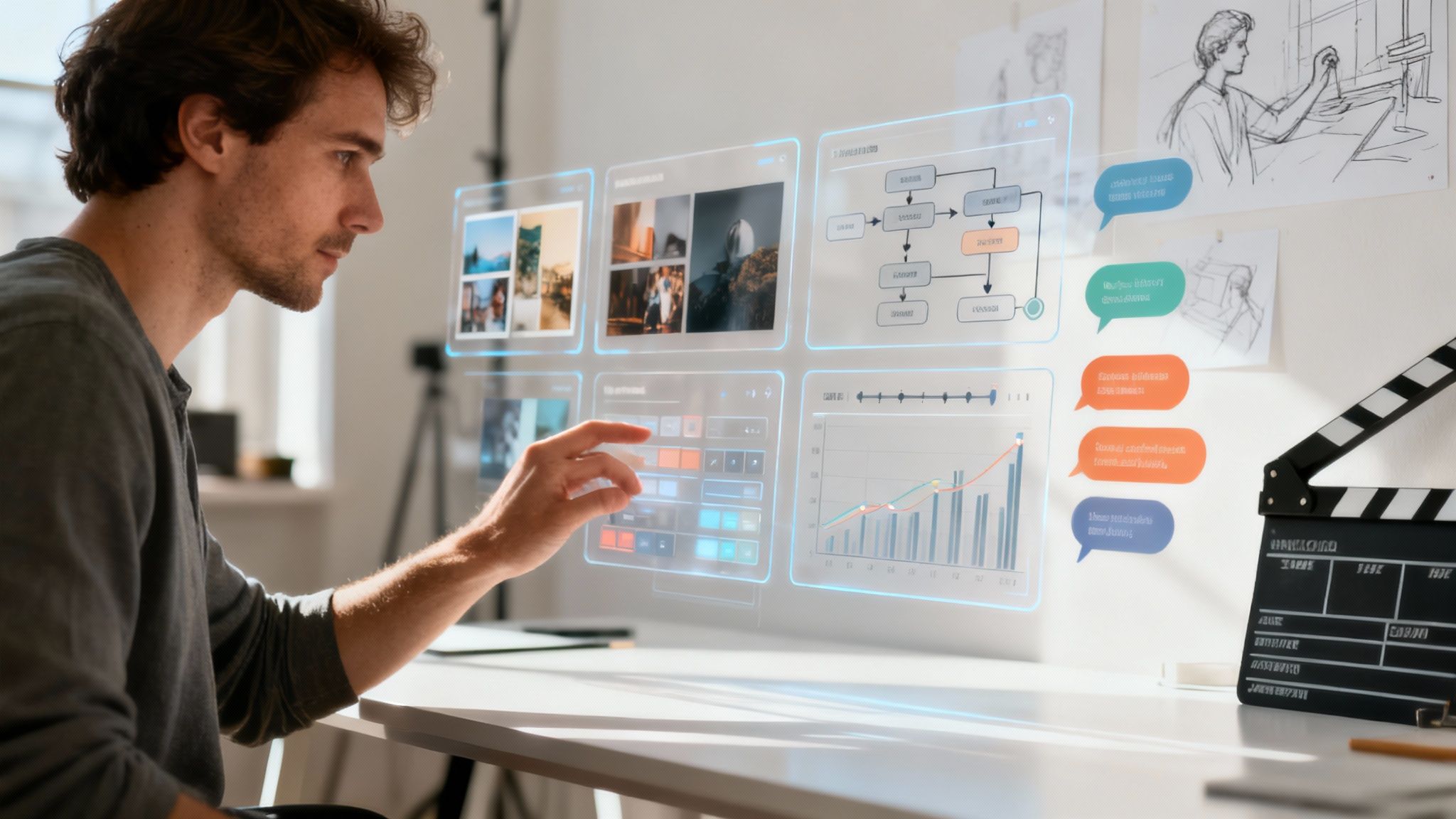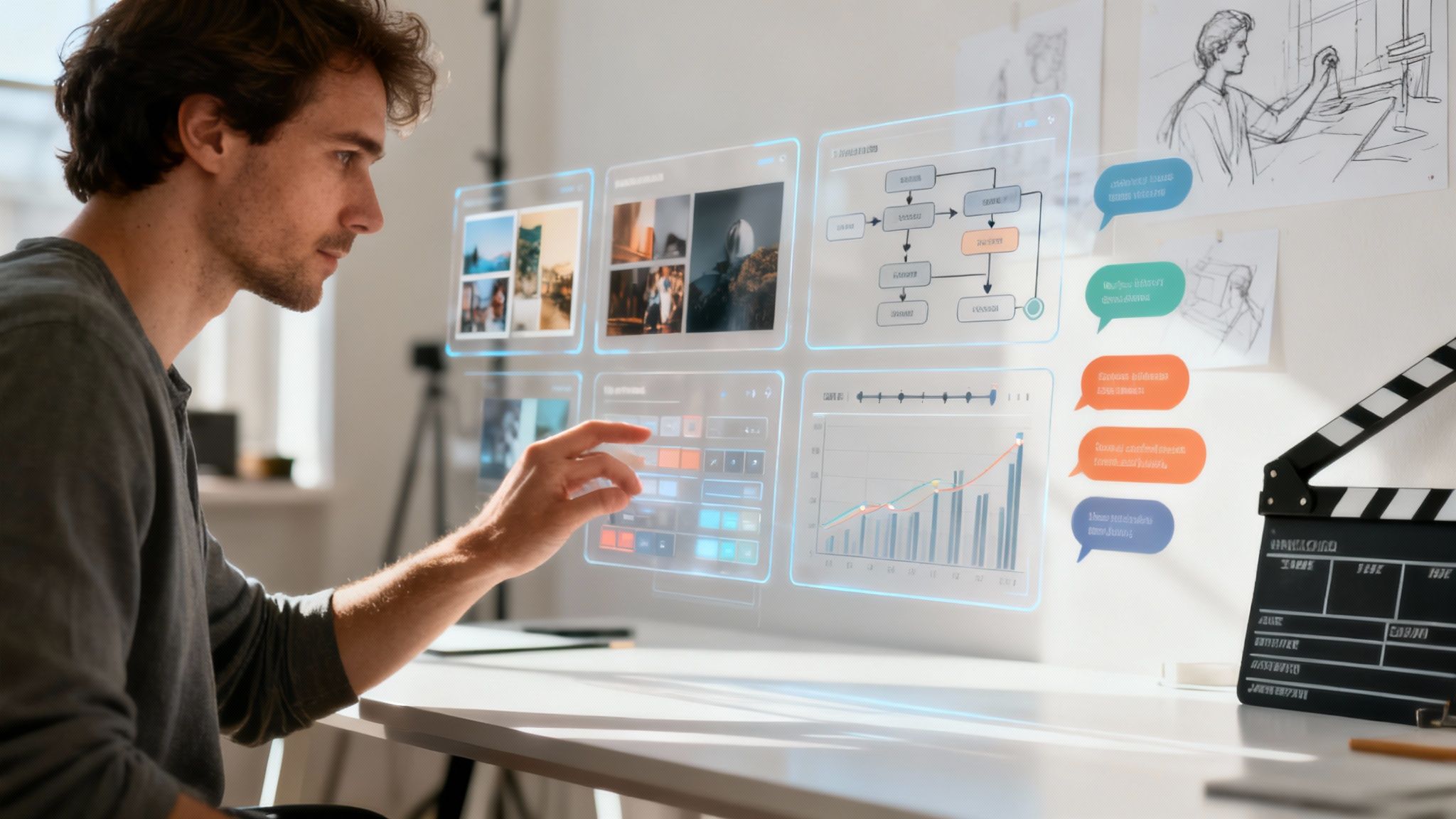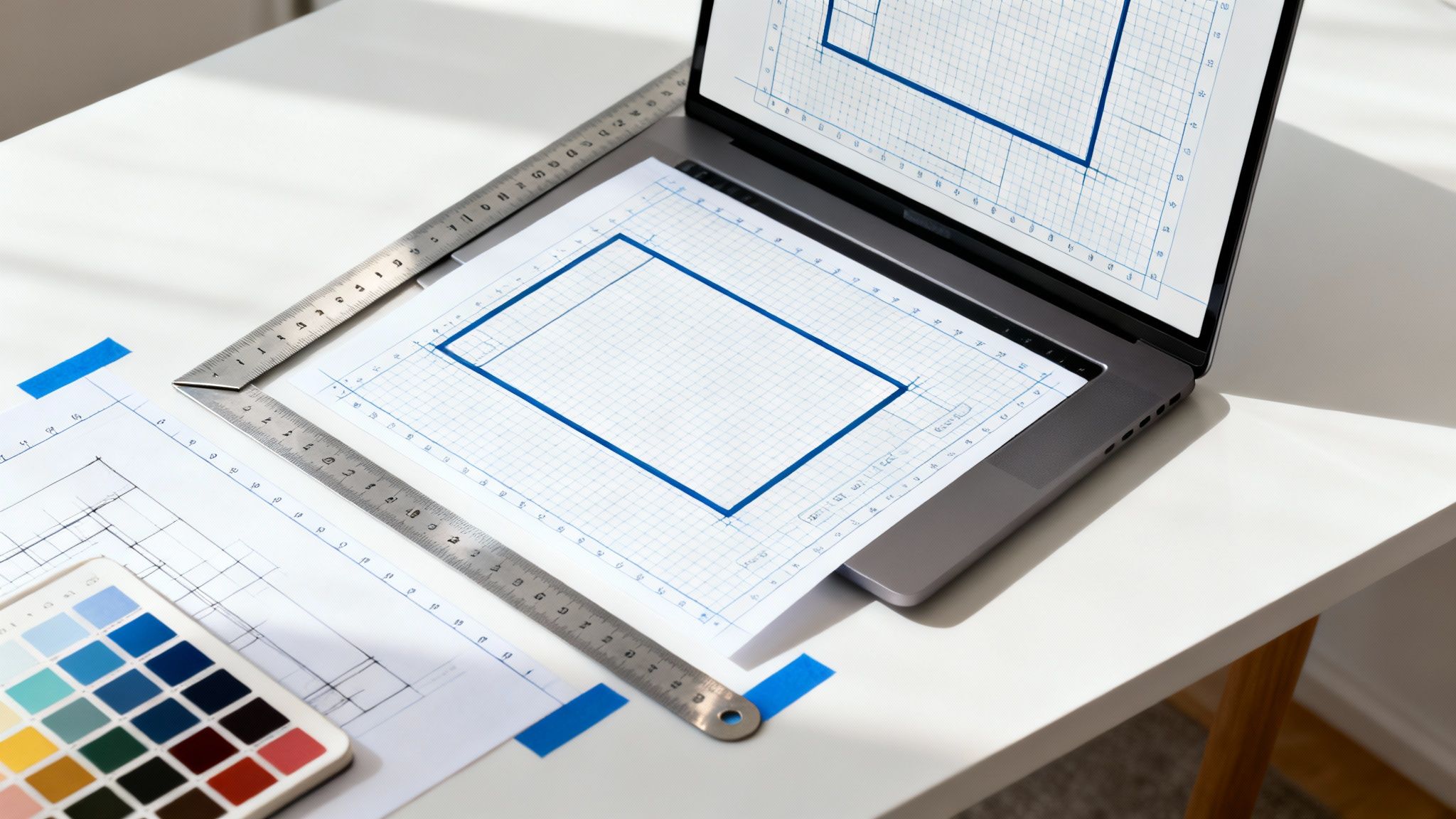Ready to transform your creative process from scattered to streamlined? Before diving in, see how a secure, enterprise-ready platform can make a difference. If you haven't generated anything with us yet, you can try Virtuall's Creative AI OS for free and experience a smarter way to manage visual projects.
Feeling the pressure of scattered visual assets, endless feedback loops, and impossible deadlines? Creative workflow management software is the answer. It’s a dedicated, secure platform built to organise, track, and automate every single step of your visual production process—from the first flicker of an idea to the final, compliant delivery.
Think of it as the central nervous system for your creative operations.
Taming Creative Chaos With Workflow Management
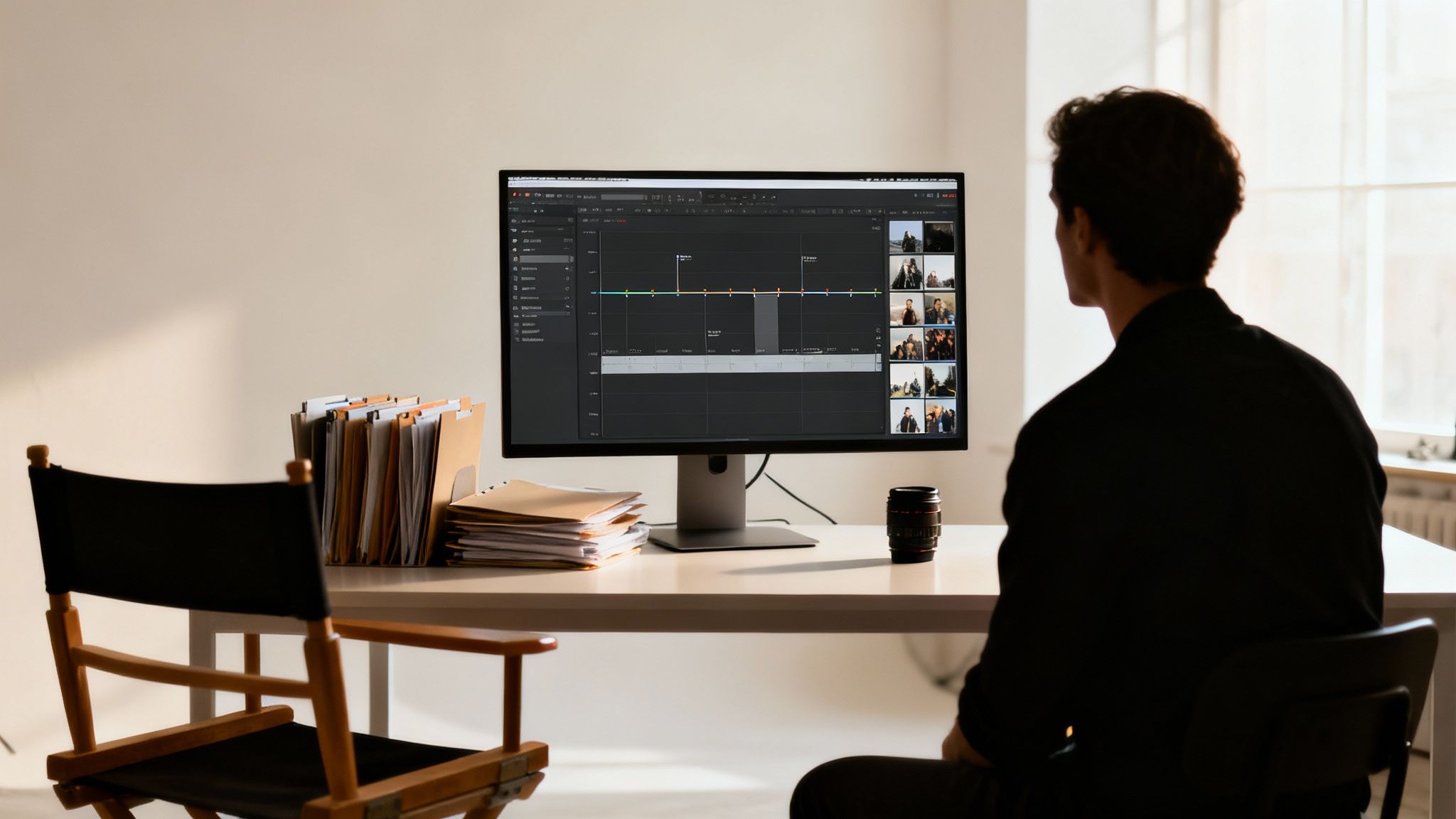
Imagine directing a major film. You've got scriptwriters, cinematographers, VFX artists, and editors all spinning different plates. Without a director to coordinate every shot and a producer managing the schedule, you’d end up with a mess. This is exactly what’s happening in too many creative teams today.
Visual creative projects are naturally complex, juggling countless stakeholders, assets, and feedback rounds. When you try to manage all that with generic tools like spreadsheets and email, crucial details get lost, deadlines slip, and frustration becomes the default. This is where a proper creative workflow management software steps in—it’s your director's chair, giving you the visibility and control to guide every part of the process in a secure, compliant manner.
The Core Problem It Solves
The real challenge for most creative teams isn't a lack of talent; it's a lack of a secure, structured framework. Cobbling together disconnected tools creates friction that slows down production and kills creativity. A purpose-built platform solves this by creating a single source of truth.
This unified space ensures everyone, from a 3D artist to a project manager, is working from the same information and the most current version of an asset. To truly tame the chaos, it helps to understand the fundamentals of creative workflow management and how to apply them.
Why Standard Tools Fall Short
General project management tools are fine for tracking linear tasks, but they just can't keep up with the specific demands of visual content creation. They don't have built-in features for asset versioning, visual annotation, or complex, auditable approval cycles required by enterprise teams.
A study found that creative professionals spend only 26% of their time on actual creative work. The rest is eaten up by admin, meetings, and navigating clunky processes.
That statistic is a huge red flag—and a massive opportunity. By adopting a system designed for visual creatives, you can claw back those wasted hours and empower your team to focus on what they do best: creating stunning visual content. This guide will show you exactly how to do it.
Key Features That Power Creative Teams
Let's be honest, modern creative workflow software is a lot more than just a glorified to-do list. The right platform solves the real, nagging problems that visual teams hit every single day, turning a scattered mess into a smooth, synchronised operation. These tools are what keep the momentum going and help you ship high-quality work, consistently and safely.

So, let's break down the core features that the best visual creative teams simply can't live without. Knowing what to look for will help you cut through the noise and find a tool that actually makes a difference.
Centralised Asset Management
We’ve all been there. That sinking feeling as you hunt for the latest version of a file. Was it in an email thread? A random Slack channel? A shared folder named "Final_v2_USE_THIS_ONE"? It’s a massive waste of time and a huge risk for using outdated assets.
A solid creative workflow management software gives you a central hub for all your visual assets, often called a Digital Asset Management (DAM) system. This becomes your team's single source of truth for every image, video, 3D model, and design file. No more guessing.
Think about a global ad campaign. You have teams in different time zones needing the same brand logos and product shots. With a centralised, secure system, the designer in Copenhagen and the marketer in New York are pulling from the same approved library. Brand consistency is locked in, and version control means everyone knows which file is the final one.
Collaborative Review And Approval Tools
Nothing kills momentum like a vague email with feedback like "make it pop." Shuffling files back and forth for review is slow, painful, and leads to all sorts of mix-ups. The best platforms solve this with tools that let you annotate and review right on the visual asset itself.
This means stakeholders can drop comments and even draw directly on the image or model. Instead of trying to describe a change, a client can just circle an element and write, "Change this button colour to our primary blue."
This direct feedback loop is a game-changer for visual projects:
- Clarity: The feedback is visual and in context. No more guesswork.
- Accountability: All comments and approvals are logged in one place, creating a clear, auditable trail of every decision.
- Speed: Revision cycles get cut down dramatically because the feedback is immediate and easy to act on.
Task Automation And Custom Workflows
Let’s face it, repetitive admin tasks are a massive drain on creative energy. Think about all the time wasted converting file formats, sending "just checking in" emails, or manually moving a card from "In Review" to "Approved."
Task automation is a core part of any powerful creative workflow software. It handles all those recurring jobs for you. You can build custom workflows that trigger actions automatically. For instance, when a designer marks a task "Ready for Review," the system can instantly notify the project manager and the client.
Professionals often spend less than 30% of their time on actual creative work. The rest gets lost in administrative overhead. Effective automation helps win that time back.
By automating the low-value stuff, you free your team to focus on what they were hired to do: high-impact visual creative work that actually drives the business forward. Exploring different creative project management tools can give you a better feel for how platforms handle automation. The goal isn't just to organise tasks, but to actively speed up your entire production line.
The Real Payoff of a Smarter Workflow
Forget the feature lists for a moment. The real measure of creative workflow management software isn’t what it does, but what it delivers. Adopting a platform isn't just about tidying up tasks; it’s a strategic move that pays dividends for everyone, from the artists doing the work to the leaders signing the cheques. It fundamentally changes how visual creative teams function, creating a more efficient, collaborative, and predictable environment.
When you lift the administrative burden, creativity has room to breathe. Designers and artists finally get to pour their energy into what they do best—creating amazing visual work. This single shift away from chasing approvals and digging through folders transforms team morale and the quality of the final output.
A Massive Boost in Team Efficiency
One of the first things you'll notice is how much wasted time you get back. Creatives constantly report that huge chunks of their day are eaten up by non-creative work: hunting for assets, deciphering feedback from endless email threads, or giving manual status updates. A solid workflow system automates or simplifies all that noise.
Picture an agency on a tight deadline for a new product launch. Their old process was a mess of shared drives, Slack messages, and panicked emails. By moving to a central platform, they built an automated flow. When a designer finished a new visual, the art director was instantly pinged for review. Once approved, the file automatically went to the client, with all feedback captured right on the asset. That simple change cut their revision cycles in half and let them hit the deadline without burning everyone out.
Collaboration That Actually Works
Whether your team is in the same room, fully remote, or a bit of both, collaboration is everything for visual projects. Generic tools just don't cut it—they create silos, leading to crossed wires and wasted effort. A purpose-built platform becomes the single hub where every stakeholder can communicate in context.
A classic headache for visual creative teams is version control. Without a central system, it’s a guarantee that someone will use an old file, leading to costly mistakes and rework. A unified platform makes sure everyone is always looking at the single source of truth.
This shared space breaks down barriers. A 3D artist in Copenhagen can get real-time feedback from a marketing manager in New York, keeping everyone aligned. That transparency keeps the entire team in sync, no matter where they are. A big part of this is making sure all visual files are managed properly, which you can learn more about in our guide on digital asset management best practices.
Finally, Total Project Visibility
For managers and leaders, flying blind on creative projects is a huge risk. Without a clear overview, you have no idea if a project is on track, on budget, or about to hit a wall. A dedicated platform gives you that high-level dashboard view of everything in the pipeline.
This complete visibility is a game-changer. Managers can instantly see where a project is stalled, spot who’s overloaded, and move resources around before things go off the rails. This data-driven approach turns creative operations from a black box into a predictable, manageable part of the business.
This push for efficiency is a huge driver in the Danish software market. The broader software market in Denmark, including tools like these, is projected to hit over US$4.13 billion by 2025, as companies prioritise platforms that support this new way of working. You can discover more insights about the Danish software market on Statista.com. The trend is clear: investing in a system that gives you control and clarity over your creative workflows is no longer a nice-to-have; it's a business necessity.
How to Implement Your New Creative Workflow
Rolling out new creative workflow management software is more about people than it is about platforms. Success isn't just about flipping a switch; it’s about having a smart plan to get your team genuinely on board for the long run. The goal is to build momentum and show real value from day one.
Without a clear roadmap, even the best tool can fall flat, leaving you with a wasted investment and a frustrated team. But by following a few deliberate steps, you can guide your team through a smooth, secure transition that actually gets results.
Start With a Thorough Audit
Before you can build a better workflow, you need to understand your current one—warts and all. This first audit is easily the most important step. It’s about moving past a vague feeling that "things are slow" and pinpointing the exact moments of friction that drain time and creative energy in your visual production pipeline.
Map out a typical visual project from kickoff to delivery. Where do things always seem to get stuck? Is it during the briefing? The feedback rounds? Final asset handoff? Documenting these bottlenecks gives you a concrete problem to solve.
A great software implementation isn’t about adding cool features; it’s about fixing real, documented problems. An upfront audit makes sure you’re treating the cause of your inefficiency, not just the symptoms.
This deep understanding doesn't just guide your setup; it helps you explain the "why" behind the change to your team. That makes them part of the solution, not just people being told to use a new tool. For a closer look at structuring these stages, our guide on what pipeline management is offers a great framework for process mapping.
Define Clear Roles and Permissions
Nothing kills an efficient workflow faster than ambiguity. When nobody knows who’s responsible for what, a new system just adds to the confusion. Before you even think about inviting your team into the platform, you need to define roles and set up permissions.
This step is crucial for security and compliance. It ensures people only see the information and actions relevant to their jobs, which cuts down on noise and prevents someone from accidentally messing things up.
Think about these key roles:
- Admins: Who gets the keys to the kingdom? This person manages users, settings, and billing.
- Project Managers: Who can kick off projects, assign out tasks, and manage deadlines?
- Creatives (Designers, Artists): Who needs to upload visual work, update their status, and jump into feedback?
- Stakeholders (Clients, Execs): Who just needs to pop in, review work, and give a thumbs up?
Setting these boundaries from the start creates a clean, secure, and organised space. It makes ownership crystal clear and ensures everyone knows exactly what their part is in the new workflow—a must-have for any responsible enterprise setup.
Launch a Pilot Project
Don’t go for a big-bang, company-wide launch. Start small. Pick a single, low-risk visual project and a small group of keen team members to test-drive the new platform in a real-world setting. This approach has some huge upsides.
First, it lets you iron out any kinks in your setup on a small, manageable scale. Second, it creates a handful of internal champions who really get the platform and can help their colleagues later. But most importantly, it’s your chance to score an early win.
When you successfully deliver a project faster or with way fewer revision cycles, you create a powerful case study. You can then take that success story—backed by actual data—and show the rest of the company how valuable the new tool is. This builds genuine excitement and melts away resistance before you even start the full rollout. It turns the implementation from a top-down mandate into a proven, secure solution.
The Future Is Now With AI-Powered Workflows
Artificial intelligence has officially graduated from a sci-fi concept to a practical, powerful creative co-pilot. For visual creative teams using the right creative workflow management software, AI isn’t about replacing human talent. It's about augmenting it.
It’s about freeing your best minds from the tedious work so they can get back to what they do best: strategy, innovation, and high-value creative thinking.
This isn’t just about doing the same old tasks a bit faster. It’s about unlocking entirely new ways of working, making teams more agile, data-informed, and ultimately, more impactful. An AI-driven platform is a direct investment in future-proofing your team's creative output in a secure and responsible way.
From Manual Drudgery to Intelligent Automation
Think about all the hours your team loses on low-value, repetitive tasks. Manually tagging hundreds of photos with keywords, transcribing hours of video, or even just organising files—these jobs are necessary, but they drain creative energy.
This is where AI makes its first and most immediate impact.
AI-powered systems can now knock out these tasks in seconds. Imagine uploading an entire photoshoot, and an AI instantly tags every image with precise keywords like "urban landscape," "golden hour," and "brutalist architecture." Suddenly, they're searchable for the whole team. This kind of intelligent automation turns your asset library from a digital storage closet into a dynamic, living resource.
AI doesn't just automate tasks; it elevates them. By analysing past campaign data, AI can suggest which creative elements are most likely to resonate with a specific audience, turning creative intuition into a data-backed strategy.
This capability fundamentally changes how work gets done. It smashes common bottlenecks and gives your creatives back their most valuable resource: time.
This three-step visualisation shows the simple process of auditing, defining, and piloting a new workflow to make sure it sticks.
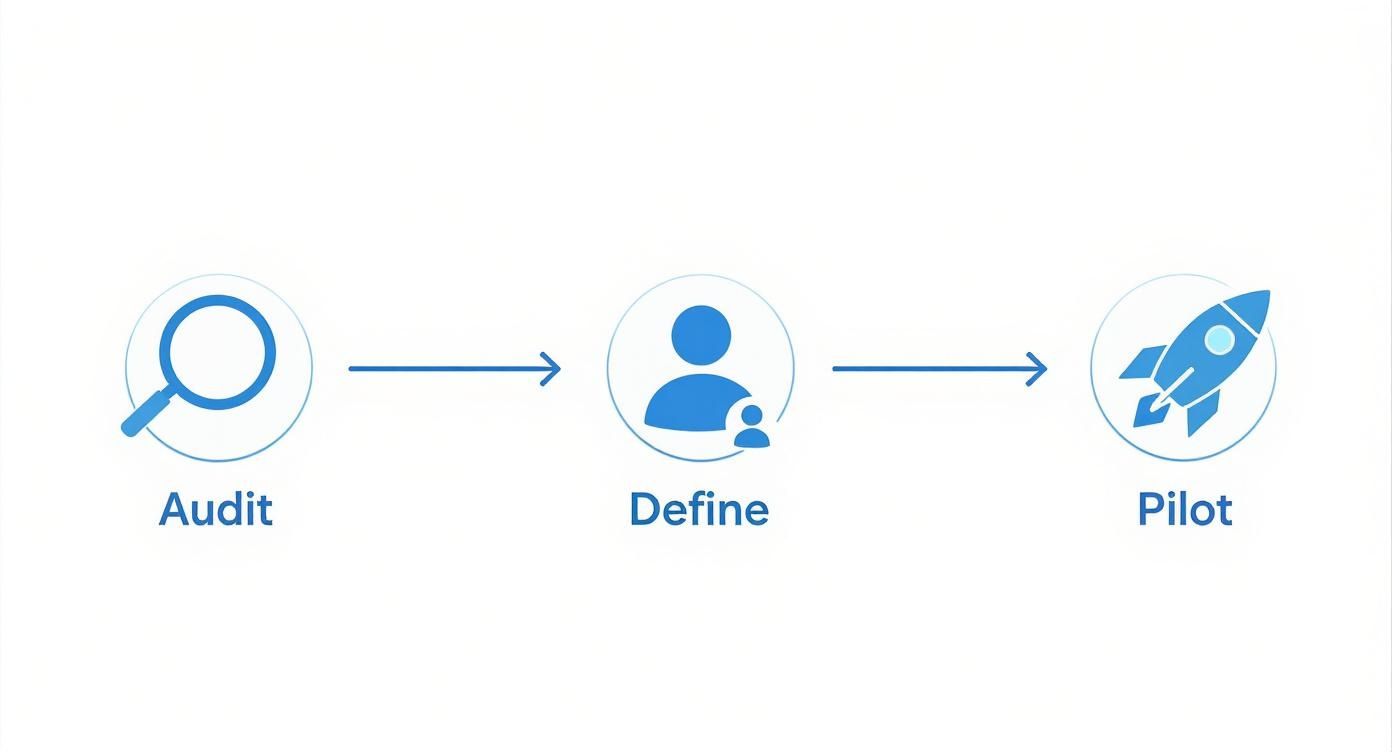
The flow highlights that successful adoption starts with understanding current pain points, followed by clarifying team roles, and then proving value with a small-scale test.
Real-World Examples of AI in Action
The applications of AI in visual creative workflows are tangible and transformative. Instead of just managing tasks, AI actively participates in the creative process. It offers suggestions and generates variations that would take a human team hours—or even days—to produce.
Consider these practical use cases:
- Campaign Content Generation: An AI can take a single approved visual and generate dozens of variations for different social media platforms. It can automatically resize images, suggest different headlines, and even create short video clips tailored to each channel's best practices.
- Video Highlight Reels: For video production teams, an AI can analyse hours of raw footage and automatically pinpoint the most engaging moments—based on visual action, emotional cues, or dialogue—to create compelling highlight reels or social media teasers in minutes.
- Layout Optimisation: Some platforms can even analyse performance data from past designs to suggest optimised layouts for new web pages or digital ads, giving your user engagement a head start.
This growing reliance on intelligent tools is reflected in market trends. The Content Management Software (CMS) market in Denmark, a sector closely tied to creative workflow management, is forecasted to reach revenues of approximately US$129 million in 2025. This growth is driven by a high degree of digitalisation and demand for secure, cloud-based solutions. For creative teams exploring advanced automation, specialised tools such as AI mobile app builders are also becoming integral to modern development workflows.
Choosing The Right Platform For Your Team
Picking the right creative workflow management software feels like a huge decision, because it is. You're not just buying a tool; you're choosing a new home for your team's entire creative process. Get it right, and you unlock speed and collaboration. Get it wrong, and you’re stuck with a system that creates more friction than it solves.
The key is to cut through the marketing fluff and focus on what actually matters for a modern visual creative team. A simple evaluation checklist is your best friend here.
Your Essential Evaluation Checklist
Before you even book a demo, run every potential platform through these three core questions. The answers will tell you whether a tool is a genuine fit or just a shiny new distraction.
- Scalability: Can this thing grow with us? Imagine your team doubles in size next year, or your project load triples. The platform needs to handle more users, more projects, and more assets without grinding to a halt. Your software should enable your growth, not cap it.
- Integration Capabilities: Does it play nice with the tools you already use? Your workflow doesn't happen in a silo. The platform must connect smoothly with your essentials—think Adobe Creative Suite, Figma, or Slack—to prevent messy data gaps and keep things flowing.
- User Experience (UX): Is it actually easy to use? A tool packed with features is useless if no one on your team wants to log in. Look for a clean, intuitive interface that your creatives, project managers, and even clients can pick up without needing a week of training.
The best creative workflow software should feel like a natural extension of how your team already works. It shouldn’t force you into a rigid, one-size-fits-all process. The goal is to remove roadblocks, not build new ones.
Security and Compliance for Enterprise Teams
This one is non-negotiable, especially for enterprise teams. Your creative assets—unreleased product designs, confidential campaign concepts, client work under NDA—are incredibly valuable intellectual property. The platform's security can't be an afterthought.
Drill down into their security protocols. Does the platform offer granular permission controls, so you can decide exactly who sees what? Is it compliant with major data security standards like SOC 2 or GDPR? A tool with weak security isn't just a bad investment; it's a major business risk. You need a partner built from the ground up to be a safe, compliant, and trustworthy enterprise option.
This isn’t just a niche concern; it’s a global trend. Here in Denmark, for example, the market for productivity software is growing steadily, driven by a national focus on efficiency and digitalisation. Projections show a clear preference among Danish companies for cloud solutions that can secure and streamline workflows. You can learn more about the productivity software market trends in Denmark on Statista.com.
Ultimately, choosing the right platform comes down to aligning the technology with your team's real-world needs. Use this framework, and you can confidently pick a solution that actually empowers creativity, locks down your assets, and sets your team up for whatever comes next.
Ready to unify your entire creative production process? Virtuall is the AI-powered Creative OS that brings 3D, image, and video workflows into one secure, collaborative workspace. Move from concept to final asset faster than ever before. https://virtuall.pro

